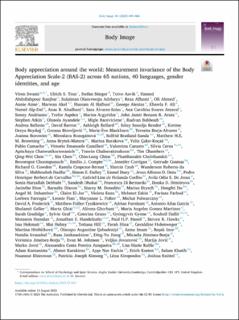Body appreciation around the world: Measurement invariance of the Body Appreciation Scale-2 (BAS-2) across 65 nations, 40 languages, gender identities, and age
Swami, Viren; Tran, Ulrich S; Stieger, Stefan; Aavik, Toivo; Ranjbar, Hamed Abdollahpour; abedayo, sulaiman; Afhami, Reza; Ahmed, Oli; Aimé, Annie; Akel, Marwan; Halbusi, Hussam; Alexias, George; Ali, Khawla F.; Alp-Dal, Nursep; Alsalhani, Anas B.; Álvares-Solas, Sara; Amaral, Ana Carolina Soares; Andrianto, Sonny; Aspden, Trefor; Argyrides, Marios; Aruta, John Jamir Benzon R.; Atkin, Stephen L.; Ayandele, Olusola; Baceviciene, Migle; Bahbouh, Radvan; Ballesio, Andrea; Barron, David; Bellard, Ashleigh; Bender, Sóley S.; Beydag, Kerime; Birovljević, Gorana; Blackburn, Marie-Eve; Borja-Alvarez, Teresita; Borowiec, Joanna; Bozogáňová, Miroslava; Bratland-Sanda, Solfrid; Browning, Matthew H. E. M.; Brytek-Matera, Anna; Burakova, Marina; Çakır-Koçak, Yeliz; Camacho, Pablo; Camilleri, Vittorio Emanuele; Cazzato, Valentina; Cerea, Silvia; Chaiwutikornwanich, Apitchaya; Chaleeraktrakoon, Trawin; Furnham, Adrian; Otterbring, Tobias; Borgen, Christine Sundgot; Trangsrud, Lise Katrine Jepsen; Voracek, Martin
Peer reviewed, Journal article
Published version

View/
Date
2023Metadata
Show full item recordCollections
Abstract
The Body Appreciation Scale-2 (BAS-2) is a widely used measure of a core facet of the positive body image construct. However, extant research concerning measurement invariance of the BAS-2 across a large number of nations remains limited. Here, we utilised the Body Image in Nature (BINS) dataset – with data collected between 2020 and 2022 – to assess measurement invariance of the BAS-2 across 65 nations, 40 languages, gender identities, and age groups. Multi-group confirmatory factor analysis indicated that full scalar invariance was upheld across all nations, languages, gender identities, and age groups, suggesting that the unidimensional BAS-2 model has widespread applicability. There were large differences across nations and languages in latent body appreciation, while differences across gender identities and age groups were negligible-to-small. Additionally, greater body appreciation was significantly associated with higher life satisfaction, being single (versus being married or in a committed relationship), and greater rurality (versus urbanicity). Across a subset of nations where nation-level data were available, greater body appreciation was also significantly associated with greater cultural distance from the United States and greater relative income inequality. These findings suggest that the BAS-2 likely captures a near-universal conceptualisation of the body appreciation construct, which should facilitate further cross-cultural research. Body appreciation around the world: Measurement invariance of the Body Appreciation Scale-2 (BAS-2) across 65 nations, 40 languages, gender identities, and age